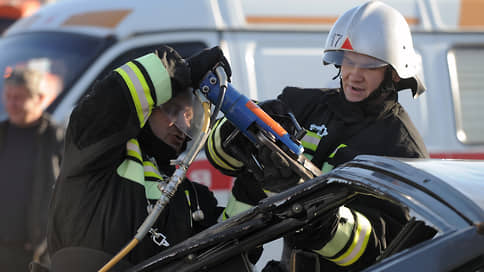An autopsy will be shown – Newspaper Kommersant No. 142 (7343) dated 08/08/2022
[ad_1]

Instructions for rescuers on the safe opening of a car in case of an accident were developed by FSUE NAMI. The document describes, among other things, scenarios for damage, fires and drowning of electric vehicles and hydrogen fuel vehicles. To help rescuers, car manufacturers will be able to put special markings on batteries, wiring, airbags and other components and assemblies of the car. However, this will not become an obligation for automobile companies.
Back in 2021, Kommersant was told, the Ministry of Emergency Situations developed a standard for car factories for compiling an electronic instruction (“rescue card”) for opening vehicles damaged in an accident. In world practice, this document is called a rescue sheet. As part of the EuroNCAP crash test system, the presence of a “card” contributes to an increase in the model’s rating as safer, which subsequently positively affects sales. Russian GOST was approved in May this year (effective from February 1, 2023). In conjunction with it, the standards developed by FSUE NAMI with more detailed instructions for automakers and rescuers will operate. The documents are currently undergoing public discussion.
The standards, in particular, provide for a color-coding system for potentially hazardous machine components. Orange means high voltage, gray means a pipeline with gasoline or diesel fuel, purple means parts of an air conditioner. Separate icons and pictograms will indicate the location of the airbag igniter, solar panel, battery, high voltage cable, high pressure gases. Labels are provided indicating “hazardous to human health”, high toxicity and environmental hazard. Some of the icons contain instructions for extinguishing the fire with water, wet or dry foam, and powder. An instruction is proposed for determining the type of energy source, for example, gasoline, battery or hydrogen. In the latter case, the attention of rescuers is drawn to the fact that hydrogen fuel burns with a colorless flame. For each model, a template should be developed with instructions for what to do if the car, for example, is flooded or on fire (where, for example, it is better to cut the body to remove the victims). NAMI used foreign experience, as stated in the explanatory materials to the document.
The development of the aforementioned group of standards is intended to establish at the interstate level the requirements for issuing an emergency response card in case of an accident, the Ministry of Industry and Trade explained to Kommersant. Energy source type marking, the agency noted, is already being applied to a number of categories of vehicles using liquefied petroleum gas or compressed natural gas as fuel. The ministry recalled that all standards in Russia are by default voluntary, unless “otherwise provided by law.” “The application of the national standard is mandatory for the manufacturer and performer in the event of a public declaration of product compliance with the national standard,” the agency explained.
“The “rescue map”, in fact, is a diagram of a car in different projections,” the press service of the Russian Emergencies Ministry explained to Kommersant. information. All this will help specialists quickly navigate the scene of an accident and unblock the victims. To do this, the diagrams will indicate the recommended areas for opening and cutting the car body. The time for rendering assistance will be reduced and the safety of the rescuers themselves will be increased.”
“I’m afraid this information will only distract from work, there is little practical use from it,” says Andrey Tumanov, first-class rescuer of the Centrospas detachment of the Russian Emergencies Ministry. “As a rule, all professional rescuers have a higher technical education, and they know well how automobile. There are universal, decades-old methods of opening vehicles, regardless of whether there is a gasoline engine or an electric one. All that can really threaten the victim, trapped in a crumpled car, is the involuntary deployment of an airbag. To prevent tripping, we have been using a special protective cover on the steering wheel for a long time. The expert believes that the appearance of additional instructions and indications on parts of the car can be perceived by drivers and eyewitnesses of an accident as a guide to action. In other words, if an accident occurs, they will decide that it is possible, without waiting for the rescuers, to cut and open something, since there are appropriate signs, and remove the victim from the car. This, in turn, may inflict additional injuries on him, Andrey Tumanov fears.
[ad_2]
Source link








